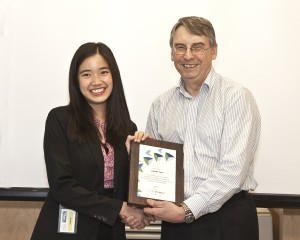I’ve always preferred the term nanobots but the folks at the University of Florida are calling them nanorobots, from the July 16, 2012 news item on phys.org,
University of Florida researchers have moved a step closer to treating diseases on a cellular level by creating a tiny particle that can be programmed to shut down the genetic production line that cranks out disease-related proteins.
In laboratory tests, these newly created “nanorobots” all but eradicated hepatitis C virus infection. The programmable nature of the particle makes it potentially useful against diseases such as cancer and other viral infections.
The research effort, led by Y. Charles Cao, a UF associate professor of chemistry, and Dr. Chen Liu, a professor of pathology and endowed chair in gastrointestinal and liver research in the UF College of Medicine, is described online this week in the Proceedings of the National Academy of Sciences.
The news item originated with a July 16, 2012 news release from the University of Florida which goes on to explain how the researchers succeeded,
The Holy Grail of nanotherapy is an agent so exquisitely selective that it enters only diseased cells, targets only the specified disease process within those cells and leaves healthy cells unharmed.
To demonstrate how this can work, Cao and colleagues, with funding from the National Institutes of Health, the Office of Naval Research and the UF [University of Florida] Research Opportunity Seed Fund, created and tested a particle that targets hepatitis C virus in the liver and prevents the virus from making copies of itself.
Hepatitis C infection causes liver inflammation, which can eventually lead to scarring and cirrhosis. The disease is transmitted via contact with infected blood, most commonly through injection drug use, needlestick injuries in medical settings, and birth to an infected mother. More than 3 million people in the United States are infected and about 17,000 new cases are diagnosed each year, according to the Centers for Disease Control and Prevention. Patients can go many years without symptoms, which can include nausea, fatigue and abdominal discomfort.
Current hepatitis C treatments involve the use of drugs that attack the replication machinery of the virus. But the therapies are only partially effective, on average helping less than 50 percent of patients, according to studies published in The New England Journal of Medicine and other journals. Side effects vary widely from one medication to another, and can include flu-like symptoms, anemia and anxiety.
Cao and colleagues, including graduate student Soon Hye Yang and postdoctoral associates Zhongliang Wang, Hongyan Liu and Tie Wang, wanted to improve on the concept of interfering with the viral genetic material in a way that boosted therapy effectiveness and reduced side effects.
The particle they created can be tailored to match the genetic material of the desired target of attack, and to sneak into cells unnoticed by the body’s innate defense mechanisms.
Recognition of genetic material from potentially harmful sources is the basis of important treatments for a number of diseases, including cancer, that are linked to the production of detrimental proteins. It also has potential for use in detecting and destroying viruses used as bioweapons.
The new virus-destroyer, called a nanozyme, has a backbone of tiny gold particles and a surface with two main biological components. The first biological portion is a type of protein called an enzyme that can destroy the genetic recipe-carrier, called mRNA, for making the disease-related protein in question. The other component is a large molecule called a DNA oligonucleotide that recognizes the genetic material of the target to be destroyed and instructs its neighbor, the enzyme, to carry out the deed. By itself, the enzyme does not selectively attack hepatitis C, but the combo does the trick.
“They completely change their properties,” Cao said.
In laboratory tests, the treatment led to almost a 100 percent decrease in hepatitis C virus levels. In addition, it did not trigger the body’s defense mechanism, and that reduced the chance of side effects. Still, additional testing is needed to determine the safety of the approach. [emphases mine]
This treatment builds on some previous research,
The UF nanoparticle design takes inspiration from the Nobel prize-winning discovery of a process in the body in which one part of a two-component complex destroys the genetic instructions for manufacturing protein, and the other part serves to hold off the body’s immune system attacks. This complex controls many naturally occurring processes in the body, so drugs that imitate it have the potential to hijack the production of proteins needed for normal function. The UF-developed therapy tricks the body into accepting it as part of the normal processes, but does not interfere with those processes.
Since there’s no mention of human clinical trials, I’m guessing that we are at least 10 years from seeing this therapeutic agent on the market.
After drafting this post yesterday (July 17, 2012) and while waiting to post it today, I found Dexter Johnson’s July 17 2012 posting where he makes some important points about this research (Note: I have removed a link),
Of course, this is a long way from becoming a treatment anytime soon. A major caveat is that the use of nanotreatments for the targeting and destroying of abnormal cells like cancer cells is always problematic since those cells are “still us” as George Whitesides noted some time back. It’s always a bit of a tricky business to make sure that nanoparticles are targeting those biological processes within us that we want stopped and not the ones we want to keep.
Dexter goes on to comment about using the terms ‘nanobots’ or ‘nano robots’; he’s less sanguine about it than I am.
